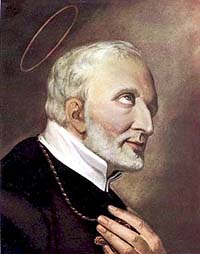Bilocation
| Part of a series on the |
| Paranormal |
|---|
Bilocation, or sometimes multilocation, is an alleged
In ancient Greece
The ancient Greek philosopher
Almost unanimous is the report that on one and the same day he was present at
A similar story is told of Apollonius of Tyana, who was supposedly present simultaneously in Smyrna and Ephesus.[4]
In religion and mysticism

The concept of bilocation has been linked with
Hinduism and Buddhism
It is also one of the have been reported to have this ability.
Christianity
The history of
Other Christian figures said to have experienced bilocation include
However, some Catholic philosophers disagree as to whether a person can really be physically located in two places at once, or whether the bilocations of the saints only take the form of non-substantial apparitions.[24][25]
Witchcraft
In the 17th century, persons accused of witchcraft were often reported to appear to their victims in visions, even if they were known to be elsewhere at the time. The trials at
described the phenomenon in his book The Discovery of Witches.Occultism
Émilie Sagée, a French teacher working in 1845 in a boarding school in Latvia, was supposed to have had the ability of bilocation.[26]
New Religious Movements
The English occultist Aleister Crowley was reported by acquaintances to have the ability to bilocate, even though he said he was not conscious of its happening at the time.[27]
Skepticism
Skeptical investigator Joe Nickell has written that there is no scientific evidence that bilocation is a real phenomenon and that cases are often from anecdotal reports that cannot be verified.[28]
Cultural influence
Bilocation figures heavily in David Lynch's film Lost Highway (1997) and both Thomas Pynchon's novel Against the Day (2006) and Tim Powers' novel Declare (2000). Bilocation also plays a part in the Christopher Priest novel The Prestige. Additionally, the phenomenon is explored in an episode of The X-Files, "Fight Club", and several season two episodes of Alcoa Presents One Step Beyond, including "Dead Ringer".
A mystical story that involved Soviet author Yevgeny Petrov served as inspiration for the film Envelope (2012), starring Kevin Spacey.
The phenomenon is one of the main ideas in Stephen King's fiction novel The Outsider, even mentioning real-life references in one occasion.
See also
References
- ISBN 0-8160-4133-4.
- ^ Porphyry. "The Life of Pythagoras (para. 27)". The Tertullian Project. Retrieved 13 October 2021.
- ISBN 0-8014-4240-0.
- ^ Philostratus. "Life of Apollodorus (4.10)". Livius.org. Retrieved 13 October 2021.
- ^ a b Tannoja, Antonio (1855). The Life of St. Alphonsus Maria de Liguori. Baltimore: John Murphy & Co. pp. 370–371.
- ISBN 0-415-33248-6.
- ISBN 0-524-07951-X.
- ISBN 978-1-61143-819-2.
- ISBN 978-1-58542-560-0.
- ISBN 0-87395-762-8.
- ISBN 1-58115-203-5.
- ^ Dass, Ram (1979) "Miracle of Love", Dutton edition, in English – 1st ed
- ^ ISBN 0-87612-086-9.
- ^ Peterson, Larry (12 October 2017). "Did you know the 1st apparition of the Blessed Mother was an act of bilocation?". Aleteia.
- ^ O'Connell, Christian E. (16 April 2015). "Rediscovering Saint Drogo of Sebourg". Crisis Magazine.
- ^ Da Rieti, Ubaldus (1895). Life of St. Anthony of Padua. Boston: Angel Guardian Press. pp. 47–48.
- ^ Guiley 2001, p. 117
- ^ Bartoli, D.; Maffei, J. P. (1858). The Life of St. Francis Xavier. London: Thomas Jones. p. 336.
- ^ Guiley 2001, p. 228
- ^ Muller, Michael (1888). "The Catholic Dogma". TraditionalCatholic.net. Chapter V, Part II, §8.
This holy virgin ... appeared, by way of bilocation, to the savages, not less than five hundred times, instructing them in all the truths of our holy religion.
- ^ Harris, W. R. (1919). Essays in Occultism, Spiritism and Demonology. B. Herder Book Co. p. 64.
- ^ Saint-Omer, Edward (1907). Life, Virtues, and Miracles of St. Gerard Majella. Boston: Mission Church. pp. 160–164.
- ^ Day, Malcolm (September 2002). "Blood brother: Padre Pio". Fortean Times. Archived from the original on 2009-02-03.
- ^ Siegfried, Francis P. (1907). . Catholic Encyclopedia. Vol. 2.
- ^ Kelly, Brian (28 September 2010). "The Miracle of Bilocation (It Isn't a Problem) and Happy Feast Day Saint Michael". Catholicism.org.
- ^ Robert Dale Owen (1860). Footfalls on the Boundary of Another World. New York: J.B. Lippincott & Company. pp. 348–358.
- ISBN 0-340-71805-6
- ISBN 1-57392-680-9

